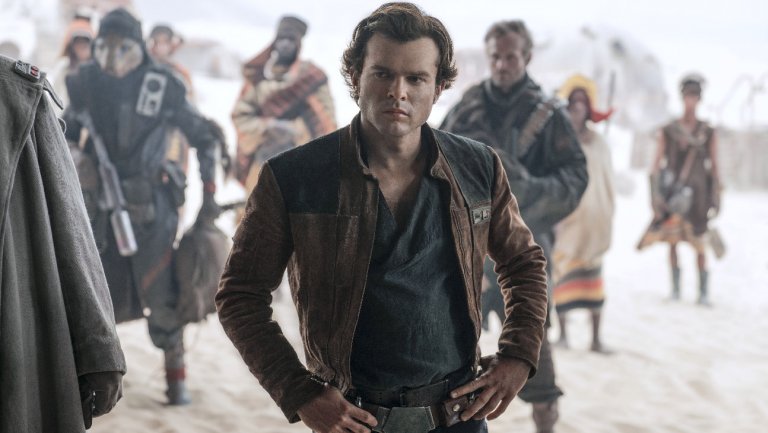
WARNING: this post is full of spoilers, including discussion of the ending of this film, as well as discussions of many other Star Wars films. You’ve been warned.
There was a time in my life when I used to go see films on opening night. As I’ve gotten older and become a father and husband, I’m more likely to skip the theater experience altogether, waiting for films to hit my local library or Redbox. Star Wars films are a slight exception; although I don’t usually see them opening night, I try to catch them in the first few weeks of release, usually with other family members.
I didn’t see Solo: A Star Wars Story opening night, either, but I did see it sooner than I often see Star Wars films. The movie came out the Thursday night before Memorial Day, and I saw it the following Monday, on Memorial Day itself. Even that early on, it was clear that things weren’t looking fabulous for the film. Opening weekend sales were not particularly special (by Star Wars standards, at least), and fans didn’t seem all that enthusiastic about the movie. Even Disney didn’t seem excited; the ad and merchandising campaigns leading up to the movie seemed muted compared to Episodes VII And VIII.

One week after the movie released, the entirety of my local Target’s promotions consisted of one tiny endcap.
Critics weren’t that impressed, either. While reviews were good, they weren’t great: Solo, the consensus determined, was a little better than Episodes I and II but worse than everything else.
It was into this context of modest expectations that I walked into the theater.
Walking out, I wondered if I’d seen the same film the critics had. Because I think one can make a decent argument that this is the best Star Wars film the Disney people have produced, and maybe the 4th best Star Wars film outside of the original trilogy.
Allow me to make my case.
This is the best “first watch” film of the Disney era.
I can respect a movie that is so deep that you have to watch it more than once to fully appreciate it. That’s true of many movies I (and many viewers) consider to be good: The Matrix, Terminator 2, Inception, Spirited Away, Casablanca, and so on. Movies that send you back to see what you missed the first time are like two great experiences for the price of one.
But the movies I mentioned are also good the first time. All of them. For example, in The Matrix, certain hints early on make more sense the second time around, but the unfolding of the plotline the first time around is still a real spectacle. All three of the original Star Wars trilogy movies are easy to follow the first time through, and deeper each time after.
That hasn’t always been true of Disney-era Star Wars films. The most egregious example is Rogue One, which opens with a dizzying succession of backstories. They only really made sense to me once I watched the film a second time, and I’ve been watching these films (and playing these video games) all my life. That, honestly, ought not to be. The Last Jedi is a lesser offender, but there is plenty in that movie, especially involving Luke and Rey on the planet Ahch-To, that is head-scratching the first time around.
By contrast, I found Solo to be a smooth first watch. The plot is easy to follow, the characters easy to keep track of. There wasn’t a single time that I found myself wracking my brain trying to figure out what just happened … but the film still managed to showcase its share of twists and turns along the way, enough that I could never quite be certain what was around the next corner.
It hits the sweet spot of plot and character development.
The Force Awakens has a decent (if incomplete) plot and so-so character development. The Last Jedi has better character development, but a middle act plotline that almost sabotages the film: a slow-speed ship chase that seems to happen for no other reason than to give Finn something to do. Rogue One’s plot is convoluted, if still mostly satisfying, but most of the characters outside of Jyn Erso and maybe Orson Krennic are so underdeveloped they feel like a half-step above cardboard cutouts. (If you can actually name everyone in Jyn’s band — and no, “cool Force-using blind guy played by Donnie Yen” doesn’t count — you’re a better person than I.)
And Solo? On the plot front, you’ve got a well-paced origin story, a military subplot that connects Han to Chewbacca, a pair of rollicking heist tales, and a number of other adventures and plot twists in between. The film has several small acts, but they tie significantly (and seamlessly) into each other in ways that really hit home in the endgame. (More on the endgame later on.)
On the character front, Solo does a brilliant job not only making you care about characters you knew about before, but also ones you didn’t. Donald Glover’s Lando is frankly inspired, but the casting of Han is respectable, and the way both are developed — and foreshadowed to become the men they will be in the original trilogy — makes sense. On the newcomer side, Paul Bettany’s Dryden Voss is a beautifully complex antagonist, Woody Harrelson’s Tobias Beckett is a multifaceted rogue, and Emilia Clarke’s Qi’ra is somehow both enigmatic and accessible. Secondary characters like L3-37 and, later on, Enfys Nest, somehow manage to be more endearing than their screen time ought to allow.
It may be steeped in more lore than any Disney-era Star Wars film.
Veteran Star Wars writer Lawrence Kasdan co-wrote the script with his son, Jonathan, and it was clear from start to finish that this was a work of true believers. The sheer number of references to events that take place before and after Solo, including multiple references to the no-longer-canon Expanded Universe, boggles the mind. Since when does a Star Wars film reference a fighting style first shown in a 20-year-old video game?
Far from feeling forced, the references feel natural, like, “yeah, this is the way that happened.” Solo feels more comfortable in the Star Wars mythology than any film set before A New Hope that I can think of. John Powell, who composed the score, adds to the mix with musical references to past films. I may or may not have gotten chills during the Kessel Run, a portion of the soundtrack that is almost a collection of auditory Easter Eggs unto itself. (Check out the YouTube video’s comments for help finding them.)
That’s not to say that the other Disney films don’t have Easter Eggs or embedded lore. Watching Jimmy Smits reprise his role as Bail Organa in Rogue One brought a smile to my face. So did the little details of the Falcon in Episode VII, and seeing Yoda as a puppet again in Episode VIII. But the quantity and quality of Easter Eggs and Star Wars lore throughout Solo is awfully impressive.
It manages to carve out new territory despite its timeline constraints.
One of the big liabilities for Solo is that much of its subject matter is already known. We know Han meets Chewy. We know he wins the Millenium Falcon in a sabacc game against Lando Calrissian. We know that certain characters live, and a few characters probably die. And we are pretty certain from the beginning that Han and Qi’ra are star-crossed.
That ought to make the storyline predictable. But it isn’t. Han doesn’t win the Falcon from Lando (not at first), certain characters survive that I didn’t expect to (Qi’ra), and, incredibly, neither heist ends the way heist plots are supposed to end. There are seeds of the Rebellion that come from the most unlikely of places, and … there are loose ends! Loose ends! What was supposed to be a standalone anthology story turns out to be anything but.
Darth Maul.
The Disney-era films all have pretty good late-game plot twists. Rey Force-snatching the Anakin’s lightsaber at the end of The Force Awakens. Kylo Ren (apparently) killing Snoke, and later getting faked out by Luke’s Force projection in The Last Jedi. And Darth Vader’s absolutely insane scene at the end of Rogue One, which might be the single best scene of the Disney Star Wars era.
But Solo doesn’t slack in this department. If you hadn’t followed the animated series Star Wars: The Clone Wars or Star Wars Rebels, there’s an excellent chance you were blindsided by the appearance of a certain former Sith apprentice. Even if you were aware that he’d survived being bisected and sent down a chute in Episode I, there’s still an excellent chance you gasped, as I did, to see him in a live action setting for the first time in nearly two decades.
Technically, he’s just Maul now, but he’s every bit the villain we remember, right down to his reconstructed lightsaber (a nod, again, to the animated Star Wars). Even more, we now know he sits atop one of the galaxy’s most notorious crime syndicates.
It leaves audiences in the dark about what comes next.
Solo, in a real way, set up a literal galaxy of future plot possibilities. The aforementioned Maul scene is just the tip of the iceberg; Qi’ra and Enfys Nest are both characters I want to see again. That, maybe, is one of the most surprising achievements of Solo — not only did it do a good job in what it did, but it threw the door wide open for what happens next in a way that rivals the end of Episode VIII.
I can’t wait.



